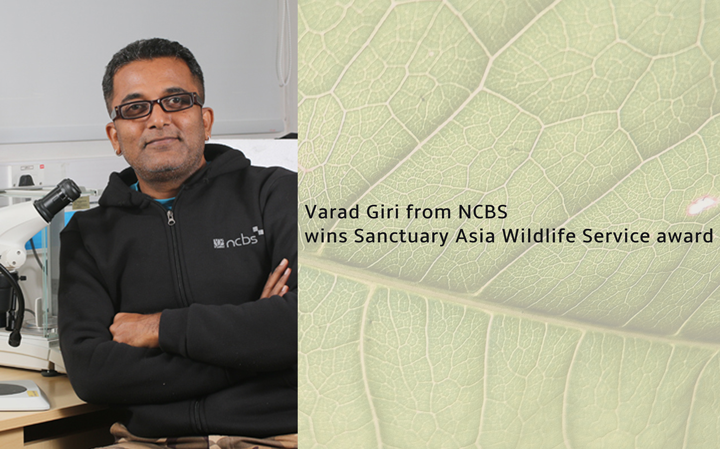Varad Giri from NCBS wins Sanctuary Asia Wildlife Service award
Within the quiet hush of the Collection Facility at the National Centre for Biological Sciences (NCBS), Bangalore, amid neat rows of closed boxes and an organised clutter of open boxes, sits a man intently focussed on taxonomy. "How do you know what to conserve or work on, if you do not even know what species the animal is?" he asks with a smile. Varad Giri is passionate about his efforts in identifying, classifying, surveying and mapping the distributions of a host of reptiles and amphibians. The tagline at the end of the article on the Sanctuary Asia website reads 'And for this, we honour him' - the honour comes with respect earned through nearly two decades of hard work and enduring gruelling field conditions while meticulously surveying remote areas.
Highly skilled in his work, Varad has published in innumerable national and international journals, is credited with the rediscovery of the Jeypore Indian gecko after 135 years and has described till date, 30 new species of amphibians and reptiles from India. He is also credited with the discovery of the first Asian species of amphibians that bear live young. Apart from these achievements, he has also inspired world-famous colleagues and students to name two newly discovered species after him - the snake Dendrepahis girii and the gecko Cnemaspis girii. Having trained and worked at the iconic Bombay Natural History Society (BNHS) for over ten years, he has brought his skills to NCBS, where he currently works as a post-doctoral fellow.
Giri's current work not only includes the establishment and organisation of the herpetology section in the Collections Facility here; he is also actively working to revise and create morphological keys for identifying reptiles and amphibians. "Morphological taxonomy as a field has not evolved as much as other fields of biology in India. I think it is important to update this field by describing variations in old characters, and investigating new characters; for example, microscopy of stained tissue and skeletal traits for species identification in herpetology. I am also trying to develop keys that will allow even people with no background in the life sciences to identify reptiles and amphibians atleast to the Genus level". Through the online courses he has conducted and networking sites like Facebook, Giri has collected a group of amateur herpetologists who often help with his work. His enthusiasm for the work he does is infectious, and Giri inspires others to follow his example in this field.
What does Giri envision for the field of herpetology in India? "I hope to see more interest in this field. Amateurs in the field of ecology are often swayed by and attracted to charismatic species such as tigers as prospective study organisms. Not many realise that there are a huge number of equally important small and less charismatic species like amphibians and reptiles to work on. In 2015, we are still struggling to document this diversity. We still don't know how many amphibians and reptiles are there in the Indian subcontinent", says Giri. A case in point is the fact that in the last 10 years, more than a 100 new species of amphibians and reptiles have been described from India. Giri is optimistic about the future of herpetology in India as people are slowly, but surely awakening to the fact that amphibians and reptiles are ecologically important. However, this area of research often entails unconventional working conditions - for example, geckos are nocturnal and very well camouflaged, which makes capturing them a challenge; and caecilians live predominantly underground and need to be dug up to be studied.
Finally, when asked how winning this award is likely to affect his work, Giri replies, "It will definitely help with my dealings with the forest department, for this is quite a prestigious award. Now, I can convince locals and forest department workers that what they casually dismiss as a 'chipkali' (lizard) is an important part of an area's ecosystem". On a more personal level, Giri feels that the award is an essential form of encouragement for him. "The recognition is important, both to me personally for having my work acknowledged, and also for future generations of researchers who will see that their work has a chance to be recognised", he adds.
About the Sanctuary Asia Awards:
The Sanctuary Asia Wildlife awards aim to recognise the contribution of individuals who actively work towards protecting the natural habitats and wildlife of India. Since their inception in 2000, the awards have drawn national attention to the the inspirational work of hundreds across the country.
For more information about the awards, please visit: http://www.sanctuaryasia.com/events/upcoming-events/10000-sanctuary-wild...

Comments
Congratulations, Varad! Wish
Post new comment